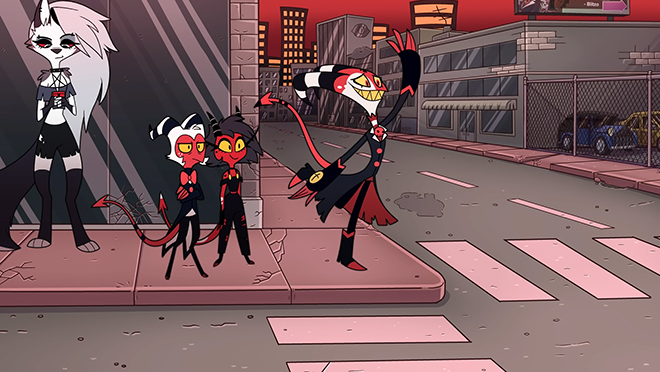Quarantine Control #125: Helluva Giant Ranger

The newest updates on COVID-19 feel like they’re a practical joke at this point. Somehow, two new Omicron subvariants have manifested, perhaps the newest evidence that we indeed live in a simulation determined to deliver maximum cruelty. It’s still comforting to think that we’ll one day get out of this, but people aren’t getting any smarter. It, in fact, feels like they’re getting dumber. We’re stuck here, and that’s just morbid to think about.
Geoffrey Barnes
Mazinkaiser (2001)
Source: It’s a secret! (It’s no longer licensed, so you can guess.)
Episodes: 7

It had been a while since I sat down to watch an anime series prior to this week. Outside the third Gundam: Reconguista in G film, I haven’t watched any in all of 2022. Perhaps that’s part of the reason why the year has been so bad. After seeing my cohorts watching so much of it in the last few weeks for Quarantine Control posts and seeing mentions of anime all over my Twitter feed, it was long past time for me to watch more. I was in a Super Robot mood after playing through Live A Live, with the Near Future scenario being heavily inspired by them, which is why I chose Mazinkaiser to watch. It didn’t require knowledge of the lengthy previous Mazinger Z works from Go Nagai to watch, so I sat down to watch it after finding it on the internet. I will give no further details there, even if you ask me.
Mazinkaiser is an abridged reimaging of Mazinger Z with many of the same characters, albeit with one notable and massive change. Kouji Kabuto is again the protagonist, and the series wastes no time establishing how he fights alongside cohorts Tetsuya Tsurugi, Sayaka Yumi, and Boss (his real name is never revealed) against the gigantic forces from Dr. Hell (a name only a bit on the nose) and right-hand assistant intersex fusion Baron Ashura. The team has a tough time fighting Dr. Hell’s forces until Kouji discovers the Mazinkaiser, a special robot created as an Achilles Heel by his grandfather, made of a special nigh-indestructible alloy. The struggle for the rest of the series is for Kouji to master it, while making sure none of his friends get in trouble in the process.
The biggest difference between Mazinkaiser compared to the Mazinger Z manga and anime adaptation is the Mazinkaiser itself. This reimaging was made after the Mazinkaiser was introduced in the Super Robot Wars games, and the franchise’s then-newfound popularity as a result of that in the late 1990s and early 2000s was the reason for this series’ existence. This explains why nothing Dr. Hell and his quickly-disposed assistants stand a chance against it; the Mazinkaiser, piloted by Kouji, never takes a scratch of damage in the whole series. Can’t let anything happen to the namesake when it exists to be advertised in another series, after all.
Don’t take that as me heavily criticizing it, though. It was fun to see the creative ways in which the writers had to get around this, by realizing the pilots of the robots are human and, thus, make human mistakes. It never stops being entertaining, but it’s the kind of concept that could have only been done in a seven-episode OVA series without becoming too monotonous.
It’s also a hell of a looker. Mazinkaiser is a mini-series originally released direct to video in Japan, with this and, the episode length being about 30 minutes each, affording the creative team the chance to craft great animation, particularly for the giant robot fights. Not to mention the great opening and closing themes and sequences from Jam Project. The story itself is intentionally generic, but it never gets the chance to be gratingly predictable thanks to the short runtime. The series itself was one of the first widescreen anime series made in the early 2000s, and the lack of digital effects and reliance on classic animation techniques helped it age better than too many shows from the dark age of animation. It’s no Vandread or… well, there’s too much digitally-animated stuff that looks amateurish these days to list here, especially when upscaled to HD resolutions. It was a dark time, but this is a shining light presentation-wise.
Tolerance for the series depends on how much a person likes anime tropes, particularly those that made a home in the super robot genre in its most prominent time between the 1970s and 1990s. There’s good action, though the story itself sticks closely to being a “reimagining” to ensure that the story is overwhelmingly familiar. There are also wacky anime hijinks. Mazinkaiser is only a seven-episode series, yet they somehow still had time to shove in a beach episode. There are even two characters mostly introduced just for the fanservice they provide. It’s an OVA series too, which let the production team get away with jokes and gags that would have needed neutering in a TV series. I didn’t mind it given the throwback nature, but it’s good to know what to expect.
I’m mostly sad that Tetsuya and Jun didn’t get more time, both of whom bow out of the story early on to return for the finale. They should have gotten their own OVA sequel instead of the follow-up focusing on original and slightly-worse characters.
With this series being short and well animated, it’s a great throwback for anyone who likes the genre. But I know I’m preaching to the choir saying that considering every big super robot fan, most of whom are fellow old folks now, likely saw this OVA when ADV Films still had the license. I was hoping Discotek would have rescued it by now, but it might be more expensive than I suspect. It’s also not as if there aren’t other ways to find it, though I’m hesitant to throw any links to questionable websites here in the chance that it does get license rescued in due time. If you go looking for it though, you’re in for one of the better super robot series in the last two decades.
Angela Moseley
We’ve reached another week where I’m definitely NOT quarantining. As of this writing I’m preparing to go to Furrydelphia, a local furry convention. I haven’t been to a furry con since Anthrocon was located in Philadelphia. That was in 2005. It moved to Pittsburgh in 2006 and has been located there ever since. I’ve known about Furrydelphia for a few years now, but the con dates have usually overlapped with Otakon’s. I had planned to go in 2020, but that was obviously a no-go. We’ll see how my adventures shake out. As for what I’m watching, I’d say this is a fitting series especially when mentioning furries.
Helluva Boss, Season One (2020)
Source: YouTube
Episodes: 7

Helluva Boss is a series I should have checked out back when the pilot aired in 2019 on YouTube. After all, I enjoyed the pilot episode of Hazbin Hotel and Helluva Boss takes place in the same universe. Albeit, the cast of character is completely different. Of course, I had to be stubborn, figuring that I would eventually get around to the series. Even as I watched one episode with my husband and enjoyed it. What surprised me the most was the voice of Richard Steven Horvitz as one of the characters. I fondly remember Horvitz for his role as Dagget from the 1997 animated series, The Angry Beavers. Of course, Horvitz is better known as Zim from 2001’s Invader ZIM. If Helluva Boss could get that kind of legendary voice actor, it wasn’t just a regular short animated series on YouTube. (Please don’t take that as a ding against indie animators. They work hard and deserve better from YouTube.) It took awhile, but I finally sat down to watch Helluva Boss a few weeks ago. My only regret was not watching it sooner.
Hell is a tough place to live, but an imp named Blitzø (the ø is silent) has the perfect small business figured out. Introducing Immediate Murder Professionals aka, I.M.P. This handy, dandy murder business is run by Blitzø (Brandon Rogers) and he employs Moxxie (Richard Steven Horvitz) a gun specialist, Millie (Vivian Nixon) a combat expert (also Moxxie’s wife), and Loona (Erica Lindback) a hellhound and unhelpful assistant. The denizens of Hell can settle old grudges on Earth by hiring I.M.P. to take out those who wronged them in life. Normally imps can’t travel freely from Hell to Earth, but Blitzø is in possession of a Grimoire, a book that allows this travel. The book is on borrow from Stolas (Bryce Pinkham), an owl demon and prince of hell who’s also a member of the Goetia family. Stolas allows Blitzø to use this book in exchange for sexual favors. While on Earth I.M.P. accomplishes their tasks, but also make a mess of things as they try to keep the presence of demons concealed from humans. (Spoiler: they’re not doing very well on this front.)
I started with the series pilot which isn’t required watching, but is a good way to get a feel for the series. What delighted me the most about Helluva Boss is not only the focus on the I.M.P. as an organization and the work they do, but the characters as whole. Sure, this is adult animation that is both violent and comedic, yet there’s a lot of character development and heart. Blitzø is the main character and could be considered an ace. Yet deep down inside he’s a broken person and seems to be unconsciously seeking relationships to fill the void in his heart. For example, his fascination with Moxxie and Millie’s wholesome marriage is a mix of pathetic and sympathetic. Sure, it’s mostly played for laughs, but the void in Blitzø’s own life is easy enough to see. He tries to fill some of it by adopting Loona (at 17-years-old no less), but their relationship is strained at best. His relationship with Stolas is fairly transactional, though it’s clear Stolas wouldn’t mind more. However, Blitzø has a recurring habit of being distant in his relationships to avoid being potentially hurt.
Design-wise Loona is one of the coolest characters in my humble opinion. That said, her personality is a bit too standoffish for my tastes, though she’s socially awkward at heart. Seeing her in action is a lot of fun. She seems to be the only one in I.M.P. that can actually read the Grimoire. Furthermore, the episode where she joins the crew on Earth is hilarious when she is exasperated to learn the imps don’t have proper disguises, aka glamour when they’re working. Given this, it’s not surprising the crew is captured several times and is occasionally in need of rescue.
Going back to characters, Stolas ended up being the character I liked the most. Sure, he’s powerful and wealthy, but his life is incredibly flawed. His plight of having his existence completely dictated to him is relatable. His job, his wife, his choice on whether to have a child was all decided at a young age. His wealth can’t save him from having almost no friends and an abusive relationship with his wife. His job bores him. The only thing that truly brings him joy his daughter, although their once tight bond is strained. It’s no wonder that he fell hard for Blitzø even if their relationship is mostly transactional. The exploration of Stolas’ personal life in parallel to Blitzø’s is something I’m looking forward to in season two.
What’s impressive about this indie animation on YouTube is that it is the work creation of Vivienne Medrano, aka ViziePop and her studio SpindleHorse. The studio boosts over 100 crew members, many of them artists. The animation itself is fantastic and is all created using consumer software. The voice acting is top notch and the show has a few heavy hitters. More importantly, ViziePop and her writers have made the character relationships a primary focus of this show in addition to the action and character misadventures. It also helps that the denizens of hell, especially the Goetia family aka Goetia Ars demons are well-researched. Honestly, this indie studio’s work is just as good as any corporate owned studio. Given the animation bloodbath at HBO Max, it’s important to see indie ventures succeed as viable alternatives.
If you’re a fan of animation, I’d suggest checking out a few episodes of Helluva Boss. It’s available on YouTube for free so the cost of entry only requires your time.
Joseph Daniels
With how big the anime industry has become and how much anime American fans consume, it can come as a surprise that there was once a time when not everything was brought over from Japan. This week, I’d like to briefly discuss one of those shows which sadly got passed over by American distributors, but given the time it came out, it’s probably for the best. In the era of such adaptations as Samurai Pizza Cats and Cardcaptors, the following series managed to dodge a bullet:
Juuni Senshi Bakuretsu Eto Ranger (1995)
No Official Source
Episodes: 39
Tiger content: Gaō

I say that the series dodged a bullet, but it may have been hit by another. There’s a YouTube channel that is currently hosting a fan-subbed version of this show, but the subtitles feel like whoever translated them was going for a 1990s style script, including potentially changing a bit of the plot. Tart’s crush on Gaō is revealed far earlier than I think was intended, for example. However, the story doesn’t seem to have suffered, and one can generally follow along without getting lost, so it seems better than the amateur effort that it may have received if it had been licensed for an American audience in the 90s.
The first episode opens with twelve friends having a friendly race around their floating island called Mugen. These friends represent the twelve animals of the zodiac, but unlike last week’s battle royale, these characters actually are the animals they represent. When I say that Gaō is the tiger, he actually is a tiger this time.
Even better: while the characters are anthropomorphized versions of the members of the zodiac, several of them can transform into a feral form meant for battle. You could consider this their battle morph, to borrow a term from Animorphs. Gaō in particular uses a pair of sunglasses to transform into his handsome, feral form.
Unfortunately, early in the series, Tart (what an unfortunate name in English, but then all the females in the Zodiac have food-sounding names), who represents the Rooster in the Chinese zodiac, is the recipient of some rather sexist body shaming and devastating verbal abuse from the rest of the team and as a result, she gives up her rather attractive avian body for a much more human form. Her human form is kind of generic and not as attractive, in my opinion, and it lasts for most of the rest of the series. This transformation happens in episode five, which means we barely get to see her lovely wings and cute beak before they go away.
I may be a bit smitten with her original form.
Come to think of it, I had a bit of a man crush on Ono from The Lion Guard as well, so I think I just really like birds. They can be very attractive if they want to be, and I wish that someone had told Tart that she really was attractive and that she shouldn’t listen to the uninformed opinions of those who disparaged her. I like to think that if I were the tiger of the group, I would’ve been kind to her from day one and helped her be a bit more positive about her body.
I think I just let a pretty bird sidetrack my mind from the plot of the series, sorry about that. During the friendly race, which is basically a commemoration of the original race which determined the order of the zodiac, it’s discovered that their enemy Nyanma (the cat of the Zodiac and the excluded thirteenth member) has sent monsters into the Novel Worlds with the end goal of disrupting humanity and destroying Mugen. The Novel Worlds are basically representations of various stories from human culture, from western fare like Cinderella to eastern stories like Journey to the West. In other words, this is basically Kingdom Hearts for the literature world. The race is called off and the twelve friends become the Eto Rangers and venture into the Novel Worlds to repair and restore them.
The influence of monsters on the Novel Worlds alter them at the fundamental level. For example, Journey to the West turns into a Western, presumably because the pun is too much to resist. The early episodes may start to feel a bit formulaic after a while, with the characters finding out what’s wrong, solving the problem, revealing and fighting the monster and defeating it, leaving a flower behind and turning the world back to normal. Also, not every character gets involved in every episode. At the start, five characters are chosen to save a Novel World, seemingly at random, and while inside, they can select up to two more characters for a total of seven.
I don’t think I liked Juuni Senshi Bakuretsu Eto Ranger as much as I did Juni Taisen, but it’s still a fantastic series. Oh! Before I forget, the rabbit in this series is named Cream, several years before a rabbit would appear in the Sonic the Hedgehog series with the same name.
Anyway, see you next week!
These Quarantine Control post opening and concluding paragraphs have mainly been places to muse about how bad the overall state of the world is. No, sorry, not in the mood to go any further this week. Have a nice one.





